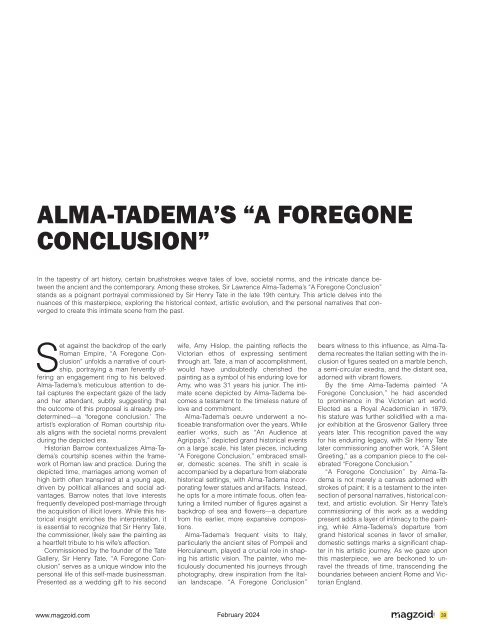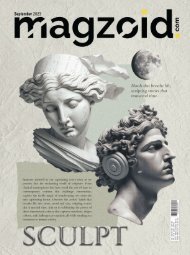Magzoid Magazine - Luxury Magazine in the Creative Space | February 2024 |
People discuss my art and pretend to understand as if it were necessary to understand, when it’s simply necessary to love. — Claude Monet Dive into the vibrant canvas of Magzoid Magazine's February edition, "The Red Edition," as we usher in the month of love with a celebration of passion, creativity, and design. Redefine your senses with the cover story unveiling the depth and intensity of the color red, a symbolic ode to love and artistic expression. In the realm of art, our exclusive interview features Pouran Jinchi, unraveling her exhibition "Fly like a Dandelion" at Third Line, exploring themes of migration. Kamran Samimi takes center stage with "Before Nature (I Am Both Created and Destroyed)," drawing inspiration from Dubai's natural materials, creating a profound dialogue between creation and destruction.
People discuss my art and pretend to understand as if it were necessary to understand, when it’s simply necessary to love.
— Claude Monet
Dive into the vibrant canvas of Magzoid Magazine's February edition, "The Red Edition," as we usher in the month of love with a celebration of passion, creativity, and design. Redefine your senses with the cover story unveiling the depth and intensity of the color red, a symbolic ode to love and artistic expression.
In the realm of art, our exclusive interview features Pouran Jinchi, unraveling her exhibition "Fly like a Dandelion" at Third Line, exploring themes of migration. Kamran Samimi takes center stage with "Before Nature (I Am Both Created and Destroyed)," drawing inspiration from Dubai's natural materials, creating a profound dialogue between creation and destruction.
Create successful ePaper yourself
Turn your PDF publications into a flip-book with our unique Google optimized e-Paper software.
ALMA-TADEMA’S “A FOREGONE<br />
CONCLUSION”<br />
In <strong>the</strong> tapestry of art history, certa<strong>in</strong> brushstrokes weave tales of love, societal norms, and <strong>the</strong> <strong>in</strong>tricate dance between<br />
<strong>the</strong> ancient and <strong>the</strong> contemporary. Among <strong>the</strong>se strokes, Sir Lawrence Alma-Tadema’s “A Foregone Conclusion”<br />
stands as a poignant portrayal commissioned by Sir Henry Tate <strong>in</strong> <strong>the</strong> late 19th century. This article delves <strong>in</strong>to <strong>the</strong><br />
nuances of this masterpiece, explor<strong>in</strong>g <strong>the</strong> historical context, artistic evolution, and <strong>the</strong> personal narratives that converged<br />
to create this <strong>in</strong>timate scene from <strong>the</strong> past.<br />
Set aga<strong>in</strong>st <strong>the</strong> backdrop of <strong>the</strong> early<br />
Roman Empire, “A Foregone Conclusion”<br />
unfolds a narrative of courtship,<br />
portray<strong>in</strong>g a man fervently offer<strong>in</strong>g<br />
an engagement r<strong>in</strong>g to his beloved.<br />
Alma-Tadema’s meticulous attention to detail<br />
captures <strong>the</strong> expectant gaze of <strong>the</strong> lady<br />
and her attendant, subtly suggest<strong>in</strong>g that<br />
<strong>the</strong> outcome of this proposal is already predeterm<strong>in</strong>ed—a<br />
‘foregone conclusion.’ The<br />
artist’s exploration of Roman courtship rituals<br />
aligns with <strong>the</strong> societal norms prevalent<br />
dur<strong>in</strong>g <strong>the</strong> depicted era.<br />
Historian Barrow contextualizes Alma-Tadema’s<br />
courtship scenes with<strong>in</strong> <strong>the</strong> framework<br />
of Roman law and practice. Dur<strong>in</strong>g <strong>the</strong><br />
depicted time, marriages among women of<br />
high birth often transpired at a young age,<br />
driven by political alliances and social advantages.<br />
Barrow notes that love <strong>in</strong>terests<br />
frequently developed post-marriage through<br />
<strong>the</strong> acquisition of illicit lovers. While this historical<br />
<strong>in</strong>sight enriches <strong>the</strong> <strong>in</strong>terpretation, it<br />
is essential to recognize that Sir Henry Tate,<br />
<strong>the</strong> commissioner, likely saw <strong>the</strong> pa<strong>in</strong>t<strong>in</strong>g as<br />
a heartfelt tribute to his wife’s affection.<br />
Commissioned by <strong>the</strong> founder of <strong>the</strong> Tate<br />
Gallery, Sir Henry Tate, “A Foregone Conclusion”<br />
serves as a unique w<strong>in</strong>dow <strong>in</strong>to <strong>the</strong><br />
personal life of this self-made bus<strong>in</strong>essman.<br />
Presented as a wedd<strong>in</strong>g gift to his second<br />
wife, Amy Hislop, <strong>the</strong> pa<strong>in</strong>t<strong>in</strong>g reflects <strong>the</strong><br />
Victorian ethos of express<strong>in</strong>g sentiment<br />
through art. Tate, a man of accomplishment,<br />
would have undoubtedly cherished <strong>the</strong><br />
pa<strong>in</strong>t<strong>in</strong>g as a symbol of his endur<strong>in</strong>g love for<br />
Amy, who was 31 years his junior. The <strong>in</strong>timate<br />
scene depicted by Alma-Tadema becomes<br />
a testament to <strong>the</strong> timeless nature of<br />
love and commitment.<br />
Alma-Tadema’s oeuvre underwent a noticeable<br />
transformation over <strong>the</strong> years. While<br />
earlier works, such as “An Audience at<br />
Agrippa’s,” depicted grand historical events<br />
on a large scale, his later pieces, <strong>in</strong>clud<strong>in</strong>g<br />
“A Foregone Conclusion,” embraced smaller,<br />
domestic scenes. The shift <strong>in</strong> scale is<br />
accompanied by a departure from elaborate<br />
historical sett<strong>in</strong>gs, with Alma-Tadema <strong>in</strong>corporat<strong>in</strong>g<br />
fewer statues and artifacts. Instead,<br />
he opts for a more <strong>in</strong>timate focus, often featur<strong>in</strong>g<br />
a limited number of figures aga<strong>in</strong>st a<br />
backdrop of sea and flowers—a departure<br />
from his earlier, more expansive compositions.<br />
Alma-Tadema’s frequent visits to Italy,<br />
particularly <strong>the</strong> ancient sites of Pompeii and<br />
Herculaneum, played a crucial role <strong>in</strong> shap<strong>in</strong>g<br />
his artistic vision. The pa<strong>in</strong>ter, who meticulously<br />
documented his journeys through<br />
photography, drew <strong>in</strong>spiration from <strong>the</strong> Italian<br />
landscape. “A Foregone Conclusion”<br />
bears witness to this <strong>in</strong>fluence, as Alma-Tadema<br />
recreates <strong>the</strong> Italian sett<strong>in</strong>g with <strong>the</strong> <strong>in</strong>clusion<br />
of figures seated on a marble bench,<br />
a semi-circular exedra, and <strong>the</strong> distant sea,<br />
adorned with vibrant flowers.<br />
By <strong>the</strong> time Alma-Tadema pa<strong>in</strong>ted “A<br />
Foregone Conclusion,” he had ascended<br />
to prom<strong>in</strong>ence <strong>in</strong> <strong>the</strong> Victorian art world.<br />
Elected as a Royal Academician <strong>in</strong> 1879,<br />
his stature was fur<strong>the</strong>r solidified with a major<br />
exhibition at <strong>the</strong> Grosvenor Gallery three<br />
years later. This recognition paved <strong>the</strong> way<br />
for his endur<strong>in</strong>g legacy, with Sir Henry Tate<br />
later commission<strong>in</strong>g ano<strong>the</strong>r work, “A Silent<br />
Greet<strong>in</strong>g,” as a companion piece to <strong>the</strong> celebrated<br />
“Foregone Conclusion.”<br />
“A Foregone Conclusion” by Alma-Tadema<br />
is not merely a canvas adorned with<br />
strokes of pa<strong>in</strong>t; it is a testament to <strong>the</strong> <strong>in</strong>tersection<br />
of personal narratives, historical context,<br />
and artistic evolution. Sir Henry Tate’s<br />
commission<strong>in</strong>g of this work as a wedd<strong>in</strong>g<br />
present adds a layer of <strong>in</strong>timacy to <strong>the</strong> pa<strong>in</strong>t<strong>in</strong>g,<br />
while Alma-Tadema’s departure from<br />
grand historical scenes <strong>in</strong> favor of smaller,<br />
domestic sett<strong>in</strong>gs marks a significant chapter<br />
<strong>in</strong> his artistic journey. As we gaze upon<br />
this masterpiece, we are beckoned to unravel<br />
<strong>the</strong> threads of time, transcend<strong>in</strong>g <strong>the</strong><br />
boundaries between ancient Rome and Victorian<br />
England.<br />
www.magzoid.com <strong>February</strong> <strong>2024</strong><br />
39
















